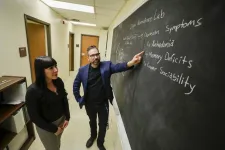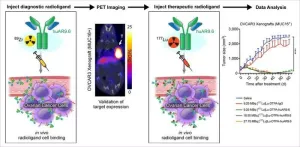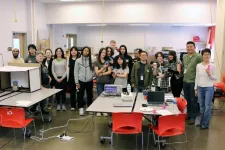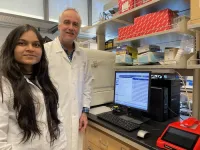(Press-News.org) Britain was already well on its way to an industrialised economy under the reign of the Stuarts in the 17th century – over 100 years before textbooks mark the start of the Industrial Revolution – according to the most detailed occupational history of a nation ever constructed.
Built from more than 160 million records and spanning over three centuries, the University of Cambridge’s Economies Past website uses census data, parish registers, probate records and more to track changes to the British labour force from the Elizabethan era to the eve of World War One.
The research shows that 17th century Britain saw a steep decline in agricultural peasantry, and a surge in people who manufactured goods: from local artisans like blacksmiths, shoemakers and wheelwrights, to an explosion in networks of home-based weavers producing cloth for wholesale.
Historians say the data suggests that Britain was emerging as the world’s first industrial powerhouse several generations before the mills and steam engines of the late 18th century – long credited as the birth of global industry and economic growth.
“By cataloguing and mapping centuries of employment data, we can see that the story we tell ourselves about the history of Britain needs to be rewritten,” said Leigh Shaw-Taylor, project leader and Professor of Economic History at Cambridge’s Faulty of History.
“We have discovered a shift towards employment in the making of goods that suggests Britain was already industrialising over a century before the Industrial Revolution.”
In fact, by the early 1800s, when William Blake was writing of “dark satanic mills”, numbers involved in manufacturing had long been flatlining. Many parts of Britain were even “deindustrialising” say researchers – as manufacturing drained from much of the nation to concentrate around coalfields.
Instead, the 19th century saw an almost doubling of the service sector – a boom often thought to have begun closer to the 1950s.* These included sales clerks, domestic staff, professionals such as lawyers and teachers, as well as a huge increase in transport workers on the canals and railways.
By 1911, some 13% of all working men were in transport. In fact, the research suggests that Britain’s service sector has been growing almost continuously for three hundred years.
The www.economiespast.org website, published today, has compiled and summarised employment statistics at local levels across England and Wales, allowing users to zoom in and trace changes to the workforce across the centuries.**
The site also breaks down by sector and, after 1851, by gender as well as age – revealing the extent of child labour. Historians hope the site will prove a valuable classroom resource, so students can explore the history of labour in their area.
The work is launched at the Economic History Society’s annual conference on 6 April.
“The question of why the industrial age dawned in Britain is a much-debated one, with coal, technology and empire all major factors,” said Prof Shaw-Taylor.
“Our database shows that a groundswell of enterprise and productivity transformed the economy in the 17th century, laying the foundations for the world’s first industrial economy. Britain was already a nation of makers by the year 1700.”
“A hundred years has been spent studying the Industrial Revolution based on a misconception of what it entailed,” he said.
‘Factories without machines’
As much of Europe continued to languish in subsistence farming, the number of male agricultural workers in Britain fell by over a third (64% to 42%) from 1600-1740.
At the same time, from 1600-1700, the share of the male labour force involved in goods production rose by 50% to just under half of working men (28% to 42%).
According to Shaw-Taylor’s estimates, the share of the British labour force in an occupation involving manufacturing rather than agriculture was three times that of France by 1700.
“We can’t say for certain why this change occurred in Britain rather than elsewhere,” he said. “However, the English economy of the time was more liberal, with fewer tariffs and restrictions, unlike on the continent.”
Moving goods within many European countries was subject to tolls from land barons, so markets were often very local. In England there are few records of such levies after the medieval era.
Shaw-Taylor argues that trade guilds also had more power in other nations. For example, textile production was prohibited in the countryside around the Dutch city of Leiden, and in Sweden no shops were permitted in rural areas within a ten-mile radius of a town until the 19th century.
Yet in the England of 1700, half of all manufacturing employment was in the countryside. “In addition to village artisans, there were networks of weavers in rural areas who would work for merchants that supplied wool and sold the finished articles,” said Shaw-Taylor.
Industries of textiles, or metalworkers making nails and scythes, were shaped like “factories without machines spread out over hundreds of households” according to Shaw-Taylor – and increasingly produced goods for international markets.
In Gloucestershire, for example, expansions in textiles, footwear and metals saw the share of the male workforce in industry grew from a third (33%) to almost half (48%) over the 17th century.
While in Lancashire, the share of men in manufacturing work grew from 42% in 1660 to 61% in 1750, driven by a doubling of textile workers (from 15% to 30%). This is all occurred prior to the Industrial Revolution.
Some networks evolved into workshops, and eventually the mills of Blake’s visions as industries migrated to the North of England, where coal was abundant and crops were harder to grow.
This meant that by the mid-18th century – considered the start of the Industrial Revolution – much of England’s South and East had actually lost its long-established industries, and even returned to farm labour, according to the research.
For example, Norfolk was probably the 17th century’s most industrialised county, with 63% of adult men in industry by 1700. But this actually dropped to 39% during the 18th century, while the share of the male workforce in agriculture jumped from less than a third (28%) to over half (51%).
As such, and counter to prevailing historical narratives, shares of the population in manufacturing-type jobs across England and Wales changed very little over the period thought of as the height of the industrial age, but rather it was the nature and location of work that shifted.
Women and children in the workforce
With textile manufacturing moving out of homes and out of the Southeast, far fewer women engaged in the labour market. Adding pre-19th century data for female workers is a major next step for the project, but researchers have devised ways of estimating earlier workforce gender splits.
“We think labour force participation for adult women was somewhere between 60-80% of in 1760, and back down to 43% by 1851,” said Shaw-Taylor. “It didn’t return to those mid-18th century levels until the 1980s.”
By 1851, Easington on the Durham coalfield had just 17% of adult women in employment. However, in one of the South’s remaining industrial hubs, Luton’s hat-making district, it was as high as 78%.
The website also allows users to track rates of child labour after 1851. The booming textile mills of Bradford saw huge numbers of young girls put to work, with over 70% of girls aged 13-14 working in 1851. Sixty years later this figure was still over 60%.
Over 40% of girls in Bradford aged 11-12 were also working in 1851, but this had fallen to nearer 10% by 1911, by which time legislation had created a system of compulsory education for young children.
The ‘Economies Past’ website is the result of a research project at Cambridge that’s been running for over 20 years, the Occupational Structure of Britain 1379-1911, which has gathered data from late medieval poll tax records to early modern coroner reports.
The main source of data from 1600-1800 comes from over two million wills and probate inventories: list of the moveable goods of the deceased. The team behind the work aim to keep expanding the datasets.
Alongside vast quantities of digitised census data, researchers also visited 80 records offices to gather data from a further 2.5 million baptism records from the 19th century (when it became compulsory to list the father’s occupation).
Notes:
* Between 1817 and 1911 the service sector grew from a 22% to a 39% share of the male workforce. Female service sector share rose from 32% in 1817 to 59% in 1911.
** The project does not have data for Scotland, so it is currently omitted. However, the researchers are hoping to add Scottish data to the website in future iterations.
The Occupational Structure of Britain 1379-1911 project has received funding from the ESRC, the Leverhulme Trust, the British Academy and the Isaac Newton Trust.
Dozens of people have worked on the project since 2003. The project was founded and directed by Professor Leigh Shaw-Taylor and Professor Sir Tony (EA) Wrigley in 2003. Sadly Tony died in 2022. Since 2016 Professor Amy Erickson has co-directed the project. Other key contributors include the late Ros Davies, Dr Sebastian Keibek, Dr Peter Kitson, Ms Gill Newton and Dr Max Satchell. END
Britain began industrializing in the 17th century – over a 100 years earlier than history books claim
2024-04-05
ELSE PRESS RELEASES FROM THIS DATE:
Bladder cancer treatment can be better targeted and more effective, trials show
2024-04-05
Testing for tumour DNA in the blood can successfully identify advanced bladder cancer patients who will not relapse following surgery, new research shows.
This could allow doctors to target treatments more effectively to those who need it, and spare those patients for whom further treatment is unnecessary, researchers say.
The findings from the screening phase of the IMvigor011 Phase III trial are presented today [Friday 5 April] at the European Association of Urology Congress in Paris.
They show that just over 90% of muscle invasive bladder cancer (MIBC) patients with a ...
Ocean floor a 'reservoir' of plastic pollution, world-first study finds
2024-04-05
New research from CSIRO, Australia’s national science agency, and the University of Toronto in Canada, estimates up to 11 million tonnes of plastic pollution is sitting on the ocean floor.
Every minute, a garbage truck’s worth of plastic enters the ocean. With plastic use expected to double by 2040, understanding how and where it travels is crucial to protecting marine ecosystems and wildlife.
Dr Denise Hardesty, Senior Research Scientist with CSIRO, said this is the first estimate of how much plastic waste ends up on the ocean floor, where it accumulates before being ...
Scientists discover potential treatment approaches for polycystic kidney disease
2024-04-04
Researchers have shown that dangerous cysts, which form over time in polycystic kidney disease (PKD), can be prevented by a single normal copy of a defective gene. This means the potential exists that scientists could one day tailor a gene therapy to treat the disease. They also discovered that a type of drug, known as a glycoside, can sidestep the effects of the defective gene in PKD. The discoveries could set the stage for new therapeutic approaches to treating PKD, which affects millions worldwide. The study, partially funded by the National Institutes of Health (NIH), is published in Cell Stem Cell.
Scientists ...
UTEP study: prairie voles display signs of human-like depression
2024-04-04
EL PASO, Texas (April 4, 2024) – Psychology researchers at The University of Texas at El Paso are making progress towards understanding the biological underpinnings of depression, a leading cause of disability that affects approximately 280 million people around the world.
In a study published this April in the Journal of Affective Disorders, UTEP psychologist Sergio Iñiguez, Ph.D., and his co-authors make the case that prairie voles, small rodents that are found throughout the central United States and Canada, can be effectively used as animal models to further the study of ...
Researchers envision sci-fi worlds involving changes to atmospheric water cycle
2024-04-04
Human activity is changing the way water flows between the Earth and atmosphere in complex ways and with likely long-lasting consequences that are hard to picture.
Land use change is altering where clouds form and how precipitation is distributed. Meanwhile, weather modification activities like cloud seeding are shifting how nations plan for water use in the face of climate change. These and other changes to the planet’s atmospheric water cycle were once hard to imagine but are increasingly part of modern water management on the planet.
Colorado State University Assistant Professor Patrick Keys is an expert ...
Novel theranostic tool allows for noninvasive identification and treatment of ovarian cancer
2024-04-04
Reston, VA—A new radiotheranostic system has the ability to detect and treat ovarian cancer noninvasively, according to new research published in the April issue of The Journal of Nuclear Medicine. Combining the highly specific huAR9.6 antibody with PET and therapeutic radionuclides, this theranostic platform may provide more personalized treatment to improve health outcomes for ovarian cancer patients.
Ovarian cancer causes more deaths than any other gynecologic malignancy, with a five-year survival rate below 30 percent for patients diagnosed at advanced stages. The current standard of care for ovarian cancer consists of surgery followed by platinum-based chemotherapy; however, ...
An NSF bootcamp for future scientists
2024-04-04
Research today doesn't only occur in a lab; indeed, many university researchers extend their work into the community with the goal of inspiring the next generation of scientists and engineers. And some government agencies, like the National Science Foundation, provide the funding to do so. Most recently, Xiayun Zhao, assistant professor of mechanical engineering & materials science at the University of Pittsburgh, completed such outreach at the Carnegie Science Center (CSC).
Zhao ...
Small protein plays big role in chronic HIV infection
2024-04-04
RIVERSIDE, Calif. -- NeuroHIV refers to the effects of HIV infection on the brain or central nervous system and, to some extent, the spinal cord and peripheral nervous system. A collection of diseases, including neuropathy and dementia, neuroHIV can cause problems with memory and thinking and compromise our ability to live a normal life.
Using a mouse model of neuroHIV, a research team led by biomedical scientists at the University of California, Riverside, studied the effects of interferon-β (IFNβ), a small protein involved in cell signaling and integral to the body’s natural defense mechanism against viral infections. The researchers found that higher or lower than ...
Perinatal women of Mexican descent propose solutions to pandemic-related stressors affecting Latinos
2024-04-04
CHAMPAIGN, Ill. — Public policies blocked many families of Mexican descent living in the U.S. from accessing vital services such as food and mental health care during the COVID-19 pandemic, even though these communities experienced some of the highest infection and mortality rates.
Thirty-eight perinatal women and mothers of young children were interviewed about the challenges they faced during the pandemic and proposed solutions to better meet the needs of their communities during future large-scale crises in a study led by University of Illinois Urbana-Champaign kinesiology and community health ...
Novel biological mechanism discovered that could lead to new treatments for neurological disorders, cancers
2024-04-04
The lab of Yongchao C. Ma, PhD, at Stanley Manne Children’s Research Institute at Ann & Robert H. Lurie Children’s Hospital of Chicago discovered a fundamental biological mechanism that could lead to new treatments for neurological diseases, such as spinal muscular atrophy (SMA) and autism, as well as different cancers. The study was published in the journal Human Molecular Genetics.
Dr. Ma’s team found that chemical modification of RNA (called RNA methylation) regulates mitochondrial ...








